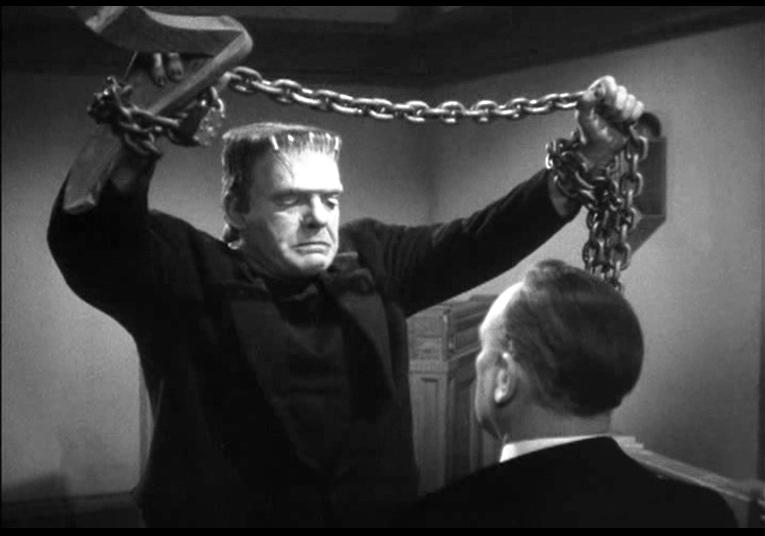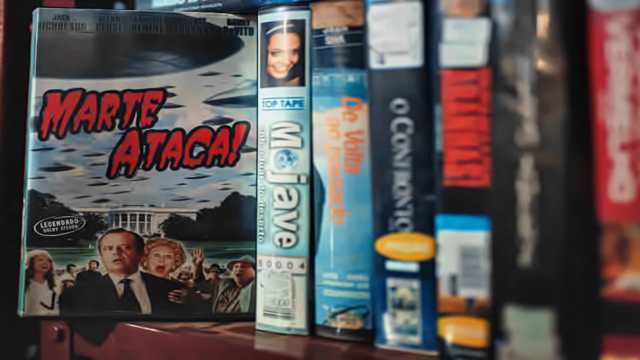
The first Universal Frankenstein film not to feature Boris Karloff as the Monster was a test-case for fresh-minted genre hero Lon Chaney Jnr and his star-maker producer George Waggner, who had provided Chaney with his hit The Wolf Man. Whilst Waggner had momentarily reinvigorated Universal’s chillers with that terrific werewolf flick, The Ghost of Frankenstein, on the other hand, represented a series clearly declining in ambition and scale, and, whilst offering in itself an attempt to bring the series to a satisfying close, pointed the way forward to the degraded last few entries. Here the drama shifts locale from the village of Frankenstein to the equally imaginary town of Vasaria

Misshapen shepherd-cum-master criminal Ygor (Béla Lugosi), having improbably recovered from the bullets Basil Rathbone’s Wolf Frankenstein fired into him at the climax of the previous film, is haunting the ruins of the since-abandoned and ruined family castle. The townsfolk, outraged that’s he’s still alive, and paranoid about the Monster’s return, decide to do what they do best – a little homunculus lynching. They commence hurling dynamite into the ruins, almost killing Ygor, but instead shattering the since solidified sulphur pit into which the Monster had previously tumbled. Of course, he’s uncovered by the blasts, revived, and Ygor helps him escape, whereupon a bolt of lightning partly restores the Monster’s nimbleness better than a bottle of Gatorade.

Ygor is inspired to take him to Ludwig, and tries to blackmail the good doctor into returning his hulking friend to full health. But the Monster makes a splash, as he often does, simply by walking into town: making friends with a tiny girl who calmly accepts him as a giant, he casually swats aside villagers who try to impede his effort to retrieve her ball from a rooftop. Ygor’s efforts to pressure the doctor result in one of his assistants being killed, so that Ludwig resolves to grant both the Monster’s wish for an end to his painful life and restore the young man’s by transplanting the dead man’s brain into the Monster’s undying frame. Ygor is at first upset that he’ll be losing a friend, but gets over that quickly when he realises he can convince Ludwig’s erratic but talented, embittered chief assistant Dr Bohmer (Lionel Atwill) into transplanting his own brain into the hulk instead. You just know that when you put Lugosi and Atwill together in the same room, no good’s going to come of it.

Director Erle C. Kenton was the new, relatively workaday ringmaster for this entry, as he would be again on House of Frankenstein (1944) and House of Dracula (1945). The frenzied opening scenes are the best in the film, with Ygor dodging blasts and trying to drop blocks of masonry on his tormentors, finally finding the monster whose wiggling fingers jut out of a lump of solid sulphur, with snappy editing and some neat stunts and explosions, before the staging settles down to a drab, limited functionalism. Gone is almost all sign of James Whale’s delirious Gothic and Lee’s monolithic Expressionism, in favour of the technically smooth but unambitious wartime studio style. If Lee’s film had certainly sped up the Monster’s transformation into a run of the mill ogre, it was far more sophisticated in design and dramatic shaping, and Rathbone’s tour-de-force of arch anxiety is swapped for Hardwicke’s far more restrained, rather haunted turn: his close-ups linger on the deep circles under his eyes, as if simply possessing the family association and trying to avoid the consequences of it has worn out his soul. The title is literalised – you don’t think we could leave it metaphoric or anything, do you? – when Ludwig is visited by his father’s ghost, or at least his own strung-out hallucination (the shade is played, unfortunately not by Colin Clive, who had died in 1937, but also by Hardwicke). Ludwig is convinced not to run away from his legacy by killing the Monster, but to try and make it work as it should have to begin with.

It’s a pity that Chaney’s lumbering, barely expressive performance is so banal: it really takes the spectacle of characterless, blank-faced, arm-jutting idiocy he provides here to appreciate just how beautiful Karloff’s mime work was. It was a few easy steps on to the brainless automaton of House of Frankenstein (1944) and House of Dracula (1945), and that’s how the Universal Monster became remembered by those who had never glimpsed Karloff’s inspired performance in the first two films. Nonetheless, in the Monster’s delight in the girl’s friendship, his overt social harassment for his disconcerting appearance, and his initial hopeful smile and then disappointed sibling rage when he spies Ludwig only for his theoretical brother to deny knowing who he is, the Monster is clearly rendered slightly more overtly sympathetic than in Son. This was thematically appropriate material for the series, and perhaps also was intended to play up Chaney’s repute for playing beleaguered everymen after Of Mice and Men (1939) and The Wolf Man. The drama of the piece moves inexorably towards putting this tortured non-man, whose only kinship is with children, to rest and giving someone else the chance to live forever through his body.

A subplot involving Ludwig’s daughter Elsa (Evelyn Ankers) and her local policeman boyfriend Erik (Ralph Bellamy), who’s as obnoxious as all pushy do-gooders are in these films, only helps fill out the running time. Lugosi’s Ygor, a surprisingly inspired grotesque performance in the first go round, is given far less time to enliven proceedings. Nonetheless, in spite of all the film’s limitations, the script is actually quite solid and even admirable in its piling on of new twists to try and enliven a flagging formula. The film builds to a clever consummation in which Ygor gains his wish, his fierce Transylvanian lisp emerging from the Monster’s mouth in proclaiming his rebirth as a Titan – although it makes no sense why the Monster would now possess his voice. Only Bohmer’s miscalculation involving rejection of body parts – Ygor is a different blood type to the Monster, as Ludwig realises – limits this ungodly new hybrid’s potential, by sending him blind, and thus ripe for roasting in another yowling mob’s conflagration. As a sequel to three of the best Gothic horror films ever made, The Ghost of Frankenstein is rather puny. But by the general standard of the 1940s genre, apart from Val Lewton’s efforts, Ghost is actually of a reasonably high calibre, and a very entertaining 67 minutes.





















